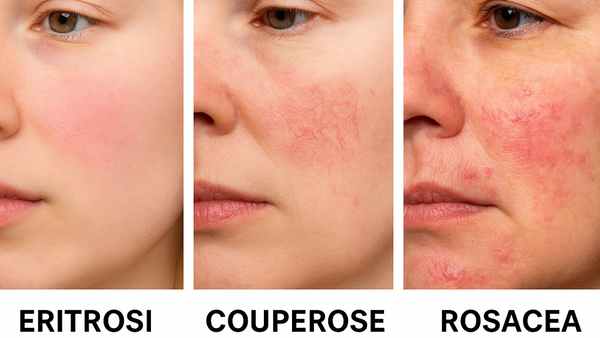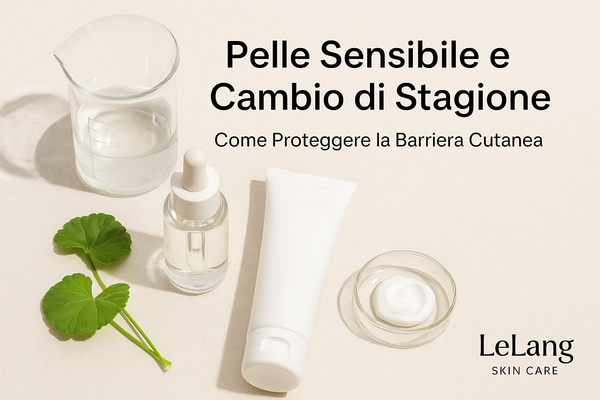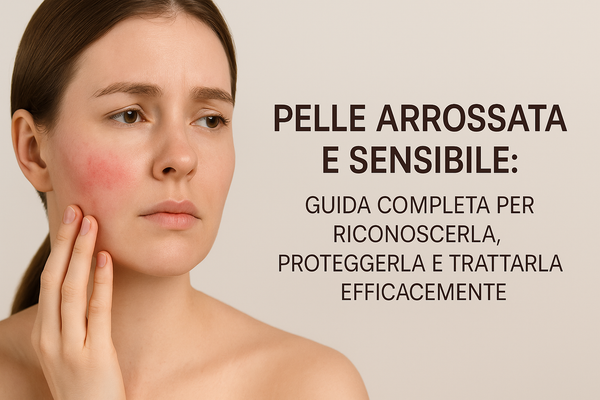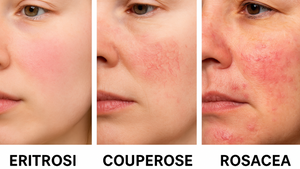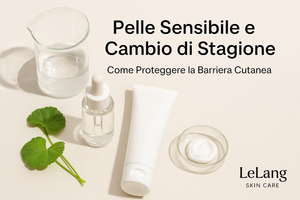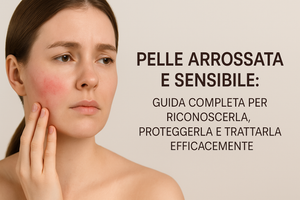Introduction
The skin barrier is one of the fundamental concepts of modern dermatology, but it is often underestimated even in the most advanced skincare protocols. Understanding what it is, how it works, and which factors damage it is essential not only for those with sensitive skin but for anyone who wants to preserve the health and beauty of their skin over time.
What is the skin barrier?
The skin barrier represents the body's first line of defense against external aggressions and constitutes a true dynamic ecosystem. Technically, it corresponds to the outermost layer of the skin, called stratum corneum, which is part of the epidermis. It is structured according to the "brick and mortar" model: the "bricks" are the dead cells (corneocytes), while the "mortar" is a lipid complex mainly composed of ceramides (about 50%), cholesterol (25%), and free fatty acids (10-20%).
This matrix is not just a mechanical barrier: it performs a function biochemical, immunological, and microbiological crucial. It maintains internal hydration by limiting transepidermal water loss (TEWL), prevents invasion by pathogenic microorganisms, and modulates the skin's inflammatory response.
If your skin tends to dehydrate easily, discover why it can become more sensitive.
According to studies by Dr. Elias and other researchers, alterations in the lipid composition of the stratum corneum are strongly correlated with barrier dysfunctions, which in turn can promote the development of dermatitis, eczema, rosacea, and premature aging (Elias PM, 2005).
Furthermore, recent discoveries highlight the importance of the skin microbiota, that is, the community of microorganisms living in symbiosis with the skin, which collaborate in maintaining the barrier function by reducing inflammation and competing with external pathogens. The skin barrier is the outermost layer of the epidermis, known as stratum corneum (stratum corneum). This structure is composed of dead cells (corneocytes) embedded in a lipid matrix mainly consisting of ceramides, cholesterol, and fatty acids. Its main function is to protect the inner layers of the skin from:
-
Pathogens: harmful microorganisms such as bacteria, viruses, or fungi that can penetrate the skin and cause infections or skin inflammations.
-
Environmental toxins: chemicals or pollutants present in the air (e.g., particulate matter, heavy metals) that can irritate, oxidize, and compromise skin health.
-
Irritants: harsh ingredients in cosmetics, cleansers, or chemicals (such as denatured alcohol or surfactants) that alter the skin's pH and damage the barrier.
-
Transepidermal water loss (TEWL): phenomenon by which water evaporates from the skin to the outside; if uncontrolled, it leads to dehydration and increased skin sensitivity.
Dermatologist Peter M. Elias, considered one of the world's leading experts in the study of skin barrier function, worked for decades at the University of California, San Francisco (UCSF). His pioneering studies revolutionized the understanding of the role of the hydrolipid film and the lipid composition of the stratum corneum in maintaining skin health. Elias introduced the concept that many dermatological conditions, including atopic dermatitis, psoriasis, and xerosis, are directly related to epidermal barrier dysfunction. A pioneer in the study of the skin barrier, he stated that "the barrier function of the epidermis is one of the most sophisticated features of human physiology" (Elias PM, 2005).
Why is it so important?
An intact barrier ensures:
-
optimal hydration: the skin barrier limits water evaporation from the deeper layers of the epidermis (TEWL), keeping the skin elastic, soft, and resistant to external aggressions.
-
local immune defense: contains specialized cells (such as Langerhans cells) that recognize and neutralize bacteria, viruses, or allergenic substances, preventing inflammatory reactions.
-
tolerance to environmental changes: regulates skin adaptation to temperature changes, humidity, and external agents, preventing these factors from triggering excessive reactions such as redness, itching, or dehydration.
When this barrier is damaged, the skin loses its ability to retain hydration and defend itself from external agents. This leads to a series of uncomfortable and visible manifestations, including:
-
tight skin, a typical symptom of skin dehydration due to increased TEWL;
-
redness, caused by greater exposure of capillaries and local inflammation;
-
itching, often associated with microlesions of the stratum corneum and irritation of superficial nerve receptors;
-
greater reactivity to cosmetics or external agents, because the damaged barrier can no longer effectively filter potentially irritating substances, promoting sensitizations and contact dermatitis.
In particular, subjects with atopic dermatitis, rosacea, acne, psoriasis or sensitive skin show an alteration in the lipid composition of the stratum corneum (Proksch et al., 2008).
Causes that compromise the skin barrier
The skin barrier can be compromised by a series of external and internal factors that alter the lipid composition of the stratum corneum, damage structural proteins, or cause inflammation. Here are the main causes:
1. Aggressive cleansing
The use of cleansers containing strong surfactants (such as SLS/SLES) and denatured alcohol can remove not only dirt but also the physiological lipids that make up the "mortar" of the skin barrier. This leads to dryness, irritation, and increased permeability to external agents.
2. Seasonal changes and climatic fluctuations
In spring and autumn, the skin is exposed to temperature fluctuations, wind, and variable humidity. These factors increase TEWL and make it harder for the skin to adapt, causing dehydration and sudden redness, especially in individuals with reactive skin. Also read what to do immediately in case of reddened skin.
3. UV radiation and atmospheric pollution
UV rays damage epidermal cells and degrade collagen, but they also compromise the skin barrier by stimulating the production of free radicals. Pollution, through fine particles (PM10, PM2.5), heavy metals, and volatile organic compounds, has a synergistic effect in damaging the skin's natural defenses.
4. Psycho-physical stress and unbalanced diet
Chronic stress raises cortisol levels, a hormone that alters the skin's ability to regenerate and maintain its structural lipids. A diet poor in essential fatty acids (such as omega-3 and omega-6), antioxidant vitamins (A, C, E), and zinc can impair epidermal lipid synthesis.
5. Excessive or incorrect use of exfoliants and dermocosmetic actives
Exfoliating acids (AHA, BHA), retinoids, mechanical scrubs, or high-concentration treatments can damage the stratum corneum if used too frequently or on unsuitable skin. Thinning of the stratum corneum reduces protective capacity and promotes the onset of sensitivity, irritation, and persistent micro-inflammations.
6. Genetic factors and individual predisposition
Some people are born with a naturally weaker barrier due to genetic mutations (e.g., filaggrin mutation in atopic individuals). In these cases, it is even more important to use products formulated to strengthen and not alter the barrier function.
Understanding these causes is the first step to adopting targeted strategies in the prevention and treatment of skin dysfunctions. These dysfunctions, if neglected, can evolve into chronic inflammatory states or affect skin tolerance in the long term.
1. Aggressive cleansing
The use of foaming cleansers with sulfate surfactants (such as Sodium Lauryl Sulfate or Sodium Laureth Sulfate), together with denatured alcohol, leads to excessive removal of the skin's natural lipids. This depletes the hydrolipidic film, the first defense against the external environment, increasing the risk of dehydration, sensitization, and superficial micro-lesions.
2. Seasonal changes
Climate transitions between seasons are physiological stress for the skin. The temperature difference between heated indoor environments and cold outdoor air (or vice versa in summer) causes fluctuations in skin humidity. Wind and dry air accelerate TEWL (transepidermal water loss), making the skin more vulnerable, dull, and reactive.
3. UV radiation and pollution
Ultraviolet radiation not only damages cellular DNA and collagen but also alters lipid synthesis and barrier function. Urban pollution (PM2.5, ozone, heavy metals) acts as chronic oxidative stress, destroying the lipid component of the skin barrier and activating subclinical inflammatory mechanisms.
4. Stress and unbalanced diet
Cortisol, the stress hormone, inhibits the synthesis of essential skin lipids and slows epidermal turnover. At the same time, a diet lacking essential fatty acids (omega-3 and omega-6), antioxidants (vitamins A, C, and E), and minerals (such as zinc) compromises the skin's regenerative capacity and alters the cohesion of the stratum corneum.
5. Excessive use of exfoliants and dermoactive actives
Overuse or non-personalized use of exfoliating acids (alpha-hydroxy acids like glycolic or lactic acid), beta-hydroxy acids (salicylic acid), and retinoids can cause excessive thinning of the stratum corneum. This reduces the skin's ability to defend against external agents and amplifies the penetration of potentially irritating substances, promoting inflammatory reactions and skin hypersensitivity.
How to tell if the skin barrier is damaged?
Identifying the signs of a damaged skin barrier is essential to intervene promptly with targeted treatments. A compromised barrier manifests through a combination of visible symptoms and subjective sensations indicating an alteration of the skin's physiological balance. Here are the main warning signs:
-
Skin that reddens easily: frequent redness, even in the absence of obvious triggers, may indicate increased skin permeability and reduced tolerance to environmental stimuli.
-
Stinging, burning, or tingling after applying cosmetic products: when the barrier is damaged, even normally well-tolerated products can cause unpleasant reactions due to increased penetration of active ingredients or preservatives.
-
Flaking or peeling skin: the loss of cellular cohesion between corneocytes and the lipid deficit compromise the structure of the stratum corneum, leading to a rough, dull skin surface prone to flaking.
-
Sudden skin sensitivity: the sudden onset of intolerance to products, temperature changes, or environmental factors can be an indicator of a compromised barrier. In some cases, there may also be an increased predisposition to contact dermatitis or atopic dermatitis.
-
Persistent dryness despite the use of moisturizing creams: when TEWL increases, even emollient treatments become less effective because water evaporates before being retained in the surface layers.
Systematically assessing the presence of these symptoms helps to understand the health status of your skin. In case of doubt, consulting an experienced dermatologist or pharmacist can guide you towards the most suitable treatment protocol.
Want to learn more about the causes of redness? Discover what can cause skin sensitization.
How to repair it: scientifically validated strategies
1. Use biomimetic ingredients
According to a study published in Journal of Investigative Dermatology (1996), the topical application of a balanced mixture of ceramides, fatty acids, and cholesterol can restore barrier function more effectively than conventional creams.
2. Sulfurous thermal water
The hyperthermal water of the Maritime Alps, rich in minerals such as sulfur, magnesium, and calcium, has demonstrated properties anti-inflammatory and soothing. A study conducted at the Department of Dermatology of the University of Montpellier showed a significant reduction in skin reactivity after 14 days of use (Benslama et al., 2012).
3. Soothing and repairing ingredients
-
Bisabolol: natural anti-inflammatory derived from chamomile
-
Panthenol (Provitamin B5): improves hydration and stimulates cell renewal
-
Hazelnut oil: rich in essential fatty acids, strengthens the lipid barrier
-
Botanical extracts such as mallow, marshmallow, and calendula: reduce redness and burning sensation
4. Avoid sensitizing ingredients
Denatured alcohol, artificial fragrances, harsh preservatives, and SLS/SLES surfactants are among the main causes of barrier alteration.
5. Minimalist skincare routine
A compromised barrier needs few, targeted, and consistent actions:
-
Gentle cleansing
-
Hydrating toner (e.g., thermal water)
-
Repair cream with dermo-affine actives
Focus: The skin barrier in individuals with sensitive skin
Sensitive skin is not a pathological condition, but a skin condition characterized by an exaggerated response to external stimuli that normally should not cause discomfort. Numerous dermatological studies show that individuals with sensitive skin present significant alterations in the structure and function of the skin barrier.
A study published in 2020 in Experimental Dermatology has found that these subjects show a transepidermal water loss (TEWL) increased by 30-40% compared to individuals with normal skin. This data suggests a compromise of cohesion between corneocytes, a reduction of the lipid component of the stratum corneum, and increased vulnerability to irritants and allergens.
Moreover, the skin microbiota of individuals with sensitive skin is often altered: the reduction of microbial diversity and the dominance of certain inflammatory bacterial species can promote the onset of a low-grade chronic inflammation. This condition predisposes the skin to excessive reactions even to mild stimuli such as wind, cold, humidity changes, too frequent cleansing, or the application of cosmetics with sensitizing ingredients.
According to French dermatologist Laurent Misery, one of Europe's leading experts on sensitive skin, skin barrier dysfunction is the key factor that triggers the irritation-inflammation cycle. He states that "the compromised skin barrier represents the gateway not only to allergens but also to nerve hyperreactivity" (Misery et al., 2016).
This skin fragility tends to worsen during particular times of the year, especially in spring and autumn, when sudden climatic changes severely challenge the skin's ability to maintain homeostasis. In subjects with sensitive skin, the change of season can trigger redness, burning, stinging, erythema, and dehydration.
For this reason, it is essential not only to treat the symptoms but also prevent barrier alterations through skincare based on dermo-affine actives, non-occlusive textures, reduction of potentially sensitizing ingredients, and regular use of cosmetics with soothing thermal water and biomimetic ceramides.
Conclusion
The skin barrier is not just a "protective film," but a sophisticated biological system that ensures balance, beauty, and health of the skin. Protecting, strengthening, and repairing it is the key to reducing redness, sensitivity, premature aging, and chronic inflammation.
Including dermo-affine actives, physiologically respectful cosmetics, and preventive strategies in your routine is the first step towards stronger, brighter, and calmer skin.
Scientific sources:
-
Elias PM. "Skin Barrier Function." Current Problems in Dermatology. 2005.
-
Proksch E, Brandner JM, Jensen JM. "The skin: an indispensable barrier." Exp Dermatol. 2008.
-
Benslama M et al. "Anti-inflammatory activity of sulfur-rich thermal spring water in the treatment of sensitive skin." Université de Montpellier, 2012.
-
Voegeli R et al. "Sensitive skin in the spectrum of TEWL." Exp Dermatol. 2020.
-
Journal of Investigative Dermatology (1996): Effects of topical lipid mixtures on stratum corneum barrier repair.


